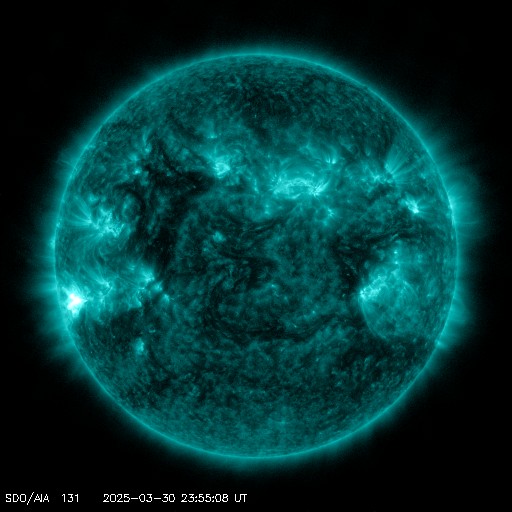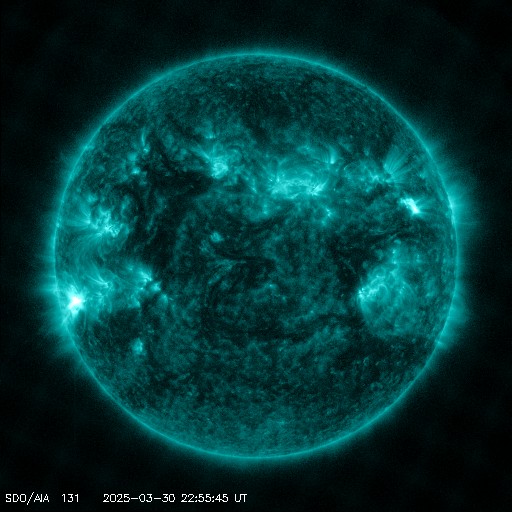Viewing archive of Wednesday, 30 March 2011
Solar activity report
Any mentioned solar flare in this report has a scaling factor applied by the Space Weather Prediction Center (SWPC). Because of the SWPC scaling factor, solar flares are reported as 42% smaller than for the science quality data. The scaling factor has been removed from our archived solar flare data to reflect the true physical units.
Report of Solar-Geophysical Activity 2011 Mar 30 2200 UTCPrepared by the NOAA © SWPC and processed by SpaceWeatherLive.com
Joint USAF/NOAA Report of Solar and Geophysical Activity
SDF Number 089 Issued at 2200Z on 30 Mar 2011IA. Analysis of Solar Active Regions and Activity from 29-2100Z to 30-2100Z
Solar activity remained at low levels. Isolated B- and
C-class flares were observed from Region 1176 (S17W37) and Region
1183 (N15E27). Region 1176 showed magnetic simplification and was
classified as an Fso group with a beta magnetic structure. Region
1183 showed a minor increase in spot count and area and was
classified as an Eai group with a beta magnetic structure. Two
filaments disappeared during the period. The first was 9 degrees in
extent, centered near N48E16, and disappeared early in the period.
The second was 7 degrees in extent, centered near S27E21, and
disappeared around mid-period. There was no significant CME activity
associated with either disappearance. A back-sided partial-halo CME
was observed early in the period, first visible in SOHO/LASCO C2
images at 29/2024Z, with an estimated plane-of-sky velocity of 1075
km/sec. The source of the CME was an active region about a day
beyond the northeast limb. No new regions were numbered.
IB. Solar Activity Forecast
Solar activity is expected to be low
during the period (31 March - 02 April) with a chance for moderate
activity (isolated M-class).
IIA. Geophysical Activity Summary 29-2100Z to 30-2100Z
Geomagnetic activity was at quiet to active levels. An active period
was observed during 30/0000 - 0300Z, followed by quiet levels for
the rest of the period. A geomagnetic sudden impulse (SI) was
observed at 30/0018Z (12 nT, as measured by the Boulder USGS
magnetometer). ACE solar wind data indicated the increased activity
was associated with a period of southward IMF Bz (maximum deflection
-8 nT at 29/2306Z) combined with increased IMF Bt (peak 15 nT at
29/2359Z).
IIB. Geophysical Activity Forecast
Geomagnetic activity is
expected to be at quiet to unsettled levels during days 1 - 2 (31
March - 01 April) with a chance for brief active levels due to
recurrent coronal hole high-speed stream effects. Activity is
expected to decrease to quiet levels on day 3 (02 April) as coronal
hole effects subside.
III. Event Probabilities 31 Mar to 02 Apr
| Class M | 40% | 40% | 40% |
| Class X | 05% | 05% | 05% |
| Proton | 05% | 05% | 05% |
| PCAF | green | ||
IV. Penticton 10.7 cm Flux
Observed 30 Mar 118 Predicted 31 Mar-02 Apr 125/130/135 90 Day Mean 30 Mar 098
V. Geomagnetic A Indices
Observed Afr/Ap 29 Mar 002/004 Estimated Afr/Ap 30 Mar 007/008 Predicted Afr/Ap 31 Mar-02 Apr 010/010-008/008-005/005
VI. Geomagnetic Activity Probabilities 31 Mar to 02 Apr
| A. Middle Latitudes | |||
|---|---|---|---|
| Active | 20% | 15% | 10% |
| Minor storm | 05% | 05% | 01% |
| Major-severe storm | 01% | 01% | 01% |
| B. High Latitudes | |||
|---|---|---|---|
| Active | 25% | 20% | 15% |
| Minor storm | 10% | 05% | 01% |
| Major-severe storm | 01% | 01% | 01% |
All times in UTC
Current data suggests there is a slight possibility for aurora to appear at the following high latitude regions in the near future
Gillam, MB, Whitehorse, YT, Yellowknife, NTAnchorage, AK, Fairbanks, AK, Juneau, AK, Utqiagvik, AK
Latest news
Latest forum messages
Solar Demon 3Unspecified geomagnetic activity 2146AR4046 134Aurora photography hints for those of us with smartphones 54AR4048 34
More topicsSupport SpaceWeatherLive.com!
A lot of people come to SpaceWeatherLive to follow the Sun's activity or if there is aurora to be seen, but with more traffic comes higher server costs. Consider a donation if you enjoy SpaceWeatherLive so we can keep the website online!

Latest alerts
00:09 UTC - Solar flare
Moderate M1.03 flare
Sunday, 30 March 2025
23:51 UTC - Radio Blackout
Minor R1 radio blackout in progress (≥M1 - current: M1.03)
23:39 UTC - Solar flare
Moderate M1.52 flare
23:21 UTC - Radio Blackout
Minor R1 radio blackout in progress (≥M1 - current: M1.49)
23:09 UTC - Solar flare
Moderate M1.48 flare
Space weather facts
| Last X-flare | 2025/03/28 | X1.1 |
| Last M-flare | 2025/03/30 | M1.0 |
| Last geomagnetic storm | 2025/03/27 | Kp5 (G1) |
| Spotless days | |
|---|---|
| Last spotless day | 2022/06/08 |
| Monthly mean Sunspot Number | |
|---|---|
| February 2025 | 154.6 +17.6 |
| March 2025 | 127 -27.6 |
| Last 30 days | 127 -25.7 |





